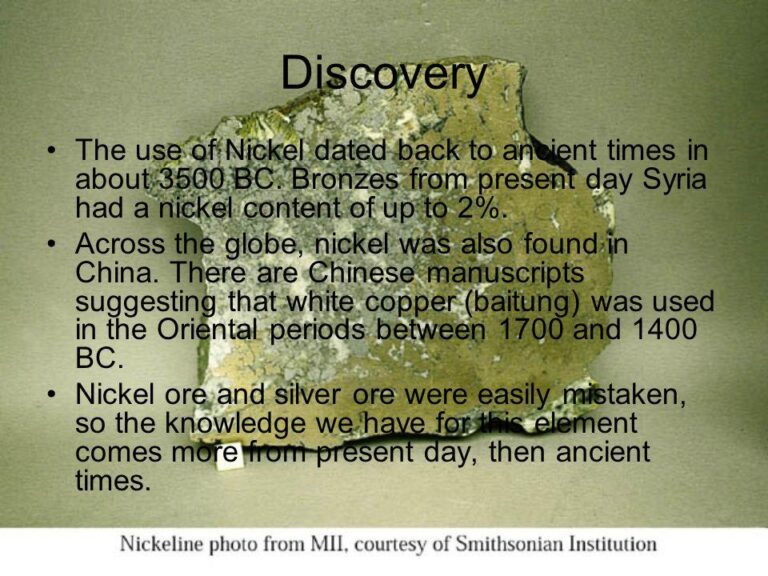Canada Nickel Company has announced a significant breakthrough at its MacDiarmid Project with the successful drilling of a 363-meter mineralized zone, marking a major milestone in the search for high-grade nickel deposits. The discovery, revealed in the latest drill results, highlights the project’s potential to become a key player in the nickel mining sector, as demand for the critical battery metal continues to surge globally. Industry analysts and investors are closely monitoring this development, which could have substantial implications for both Canada Nickel’s stock performance and the broader market landscape.
Major Nickel Uncovers Extensive Mineralized Zone at MacDiarmid Project
Canada Nickel has reported a significant breakthrough at its MacDiarmid Project, revealing a newly discovered mineralized zone that extends an impressive 363 meters. This discovery underscores the project’s potential to substantially increase nickel resources in an area known for its rich reserves. Early analyses indicate high-grade sections within this interval, positioning the MacDiarmid site as a potentially transformative asset in the nickel supply chain amid growing global demand for electric vehicle batteries and clean energy technologies.
Key highlights of the drill results include:
- Mineralized zone thickness: 363 meters with continuous nickel-bearing intervals
- High-grade core sections averaging over 0.8% nickel
- Additional co-occurrence of cobalt and copper, enhancing project economics
- Drill holes intersecting accompanied by strong magnetic anomalies confirmed by geophysical surveys
| Parameter | Value |
|---|---|
| Drill Hole Length | 363 m |
| Average Nickel Grade | 0.82% |
| Cobalt Presence | 0.05% |
| Copper Presence | 0.03% |
Implications of the 363-Meter Drill Strike for Future Resource Estimates
The breakthrough 363-meter drill strike at MacDiarmid signals a potential recalibration of the project’s resource model, suggesting that previously estimated nickel tonnages could substantially increase. Such an extensive mineralized zone points to a more continuous and thicker deposit than initially anticipated, which may enhance the overall grade and volume parameters used in upcoming feasibility studies. This discovery not only underscores the robustness of the geological framework but also sets a new benchmark for exploration targets across adjacent zones. Analysts are now closely monitoring how this data integrates into updated resource calculations and the implications for planned mine development.
Key implications for future resource estimates include:
- Expanded resource base: Increased confidence in both the size and scalability of the deposit.
- Improved economic viability: A thicker mineralized zone could reduce production costs per ton through economies of scale.
- Enhanced modeling accuracy: Refined geological interpretations may narrow uncertainty ranges in resource classification.
| Parameter | Previous Estimate | New Implications |
|---|---|---|
| Resource Depth | Up to 200 meters | Extending beyond 363 meters |
| Nickel Grade | 0.9% Ni | Potential increase to 1.1% Ni |
| Tonnes Estimate | 15 million tonnes | Projected 25-30 million tonnes |
Investment Strategies Amid Growing Interest in Canada Nickel’s Exploration Success
Investors are increasingly recalibrating their portfolios in response to Canada Nickel’s groundbreaking discovery at the MacDiarmid project. The extensive 363-meter mineralized zone has sparked enthusiasm in the mining sector, prompting a more aggressive allocation of capital towards nickel assets, which are critical for the burgeoning electric vehicle (EV) and renewable energy markets. Portfolio managers are weighing the potential for long-term value growth while balancing sector volatility, with many considering Canada Nickel’s geological data as a strong indicator of sustained resource expansion.
Key strategies emerging among market participants include:
- Targeted Exposure: Increasing direct stakes in nickel-focused juniors with promising exploration results.
- Diversification: Blending metals portfolios to include graphite and cobalt alongside nickel to hedge against commodity-specific risks.
- Long-Term Horizon: Prioritizing projects with substantial mineralization zones that promise a decade or longer of resource growth and scalability.
| Strategy | Expected Benefit |
|---|---|
| Targeted Exposure | Capitalizing on early-stage growth |
| Diversification | Risk mitigation through commodity mix |
| Long-Term Horizon | Sustained returns from resource expansion |
To Wrap It Up
The recent discovery of a 363-meter mineralized zone at Canada Nickel’s MacDiarmid Project marks a significant advancement in the company’s exploration efforts and adds momentum to the growing enthusiasm around critical mineral supplies. As demand for nickel continues to rise-driven largely by the electric vehicle and battery industries-this find positions Canada Nickel as a key player in the sector. Investors and industry watchers will be closely monitoring further drilling results and development updates as the project progresses. With global attention on sustainable and secure sources of battery metals, Canada Nickel’s MacDiarmid discovery could prove to be a pivotal asset in the evolving nickel landscape.




